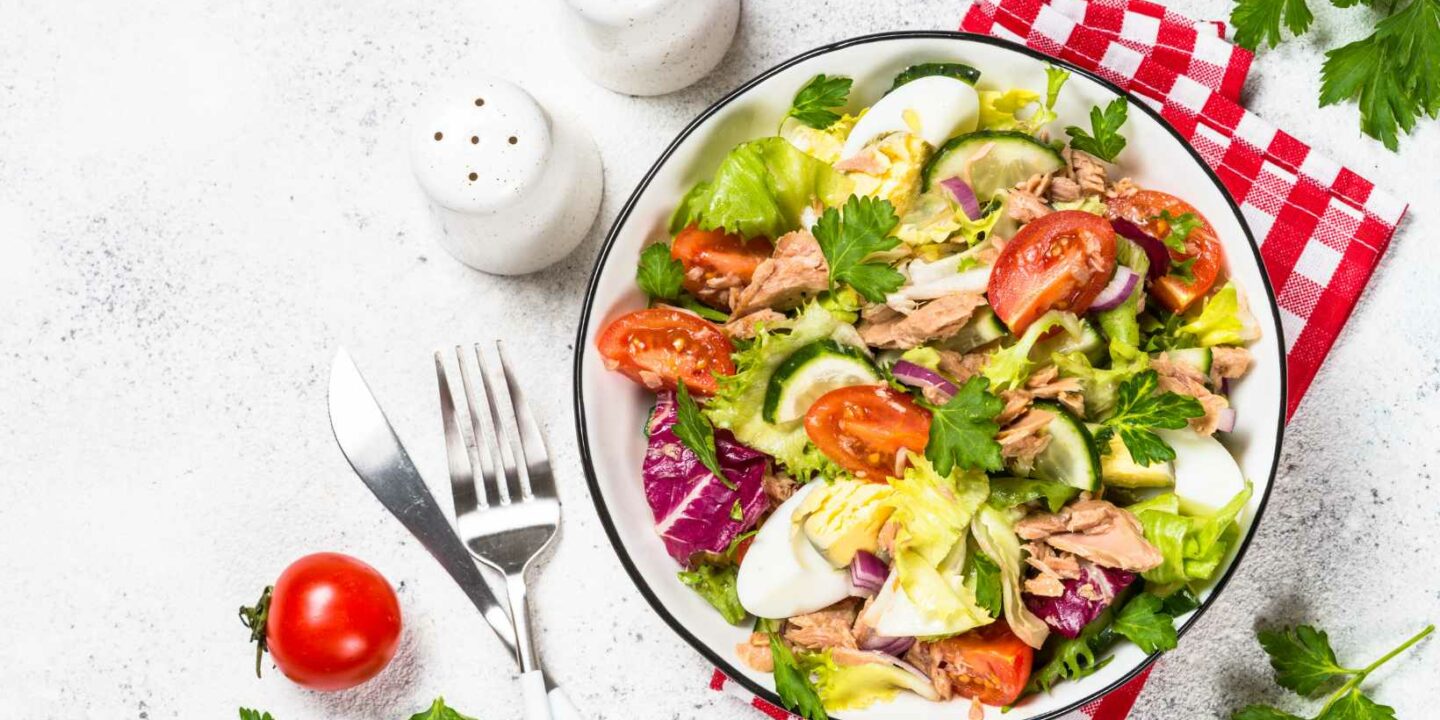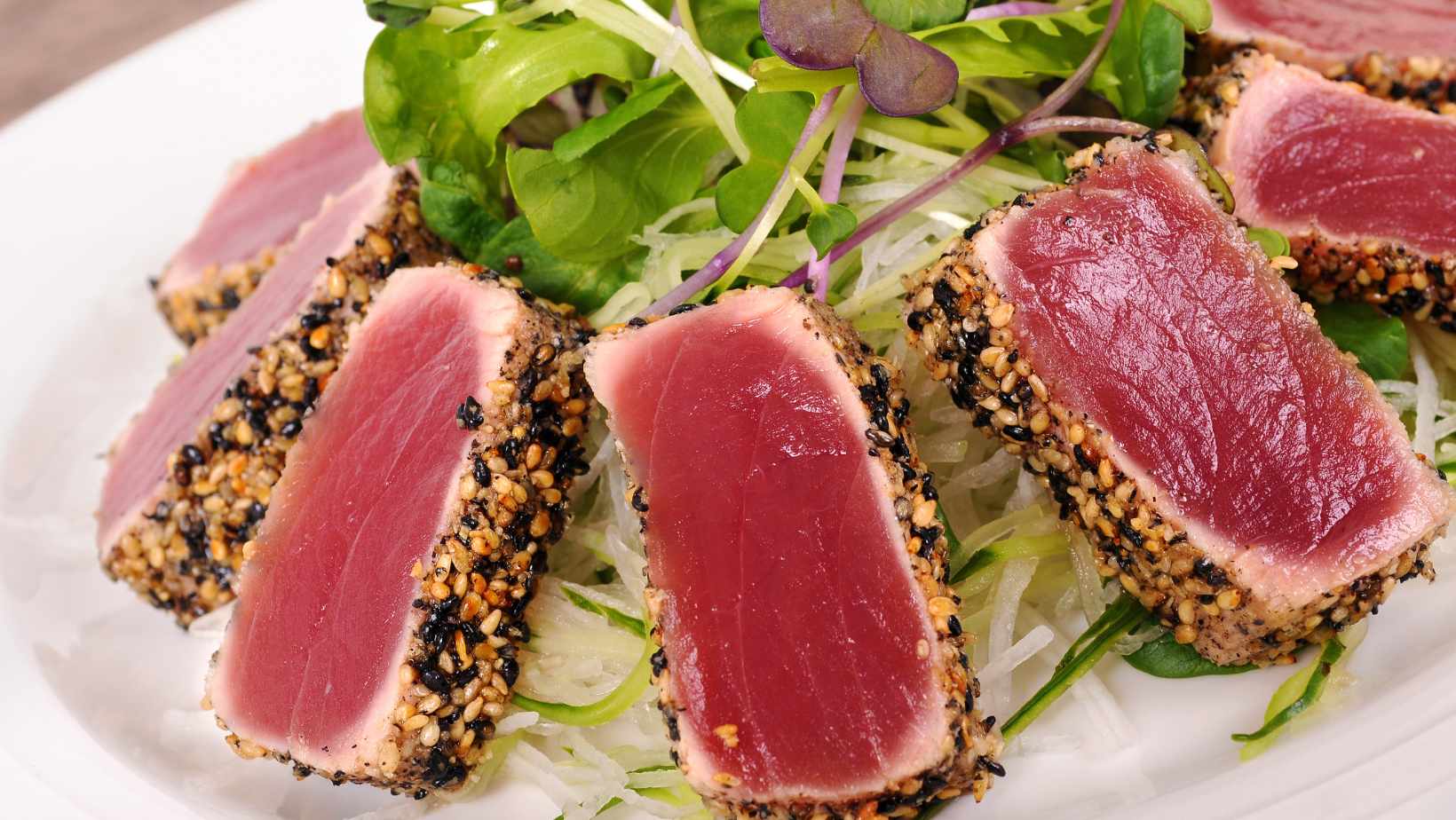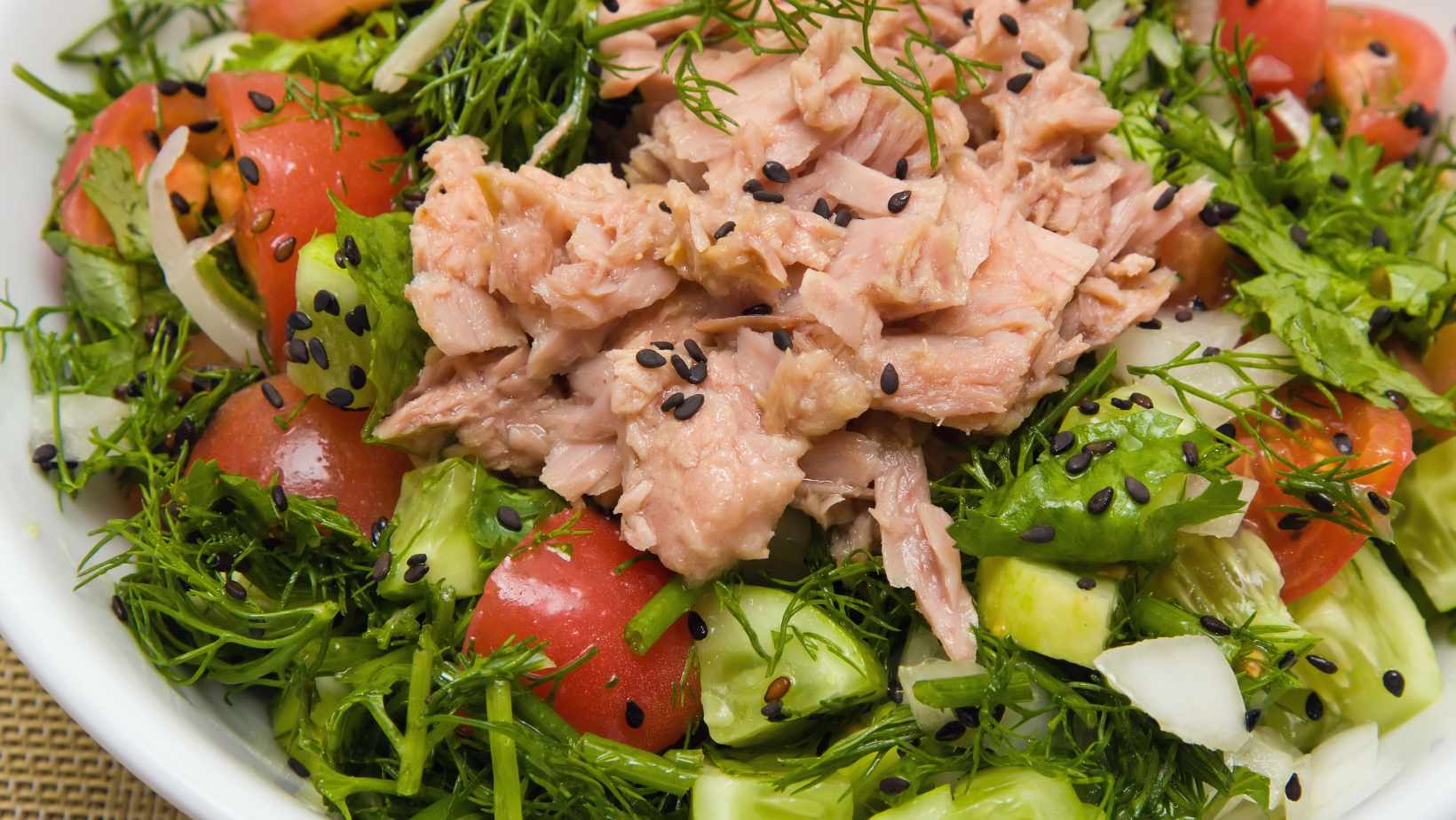
Tuna salad is a favourite for many. If you’re curious about its calorie count, it depends on the components. Generally, it’s 200-400 calories per portion. Protein and healthy fats are also included in tuna salad.
For a healthier option, try making it with low-fat mayo and adding veggies such as celery and carrots. Fresh tuna instead of canned is even more nutritious. Catching tuna may be enjoyable, but no fishing rod is necessary to know how many calories are in your tuna salad!
How Many Calories in Tuna Salad
To determine the calories in tuna salad, you need to consider factors that affect its caloric content. In this section, you will find out how many calories in tuna salad as well as the various factors that contribute to its calorie count. The subsections will explore factors affecting caloric content of tuna salad and provide you with the appropriate solution.
Tuna salad is popular. It’s important to know the calories in this dish. It depends on ingredients.A Table of calorie content of ingredients like canned tuna, mayo, celery, onions and lettuce helps.
Nutritionists watch out for carbs, proteins and fats too. Tuna is a good protein source with low fat.According to Nutritionix (2022), one cup of tuna salad has 383-517 calories, depending on the serving size.Knowing calorie intake helps maintain good dietary habits while enjoying your meal. The only factor influencing the calorie content of my tuna salad is how much mayo I add!
Factors Affecting Caloric Content of Tuna Salad
Tuna salad’s calorie count is affected by various elements. This alters its nutrient profile, making it important for those watching their diet. A table can demonstrate these factors. Here’s one example:
| Factors | Average Calories per Serving Size (approx.) |
| Type of Tuna | 80-110 cal. |
| Mayonnaise/Miracle Whip | 90-150 cal. |
| Additional Condiments/Veggies | 2-30 additional cal./serving size |
Other elements might also affect the calorie count, like preparation method or type of bread. Be mindful when estimating calorie intake.

Lower-fat mayo or plain Greek yoghourts can help keep calories down. Veg like shredded carrots, bell peppers or cucumbers boost fibre and nutrients.
Pro Tip: Monitor portion size to estimate cal. intake and keep healthy habits.
Interesting fact: Our tuna salad only has tuna. No mystery-coleslaw-from-the-deli here!
Ingredients Used
Tuna Salad is made up of many ingredients. Veggies and spices all bring something special to the salad. Here’s a list of ingredients you can get from the grocery store:
- canned tuna
- mayo
- celery
- onion
- lemon juice
- salt
- pepper
It’s important to get the right amounts for the best tasting and healthiest salad.
Nutrition values can vary depending on the type and brand of ingredients. For example, if you use low-fat mayo or fresh tuna instead of canned tuna, it’ll lower the calories.
Pro Tip: To make it low calorie yet wholesome, use olive oil-based mayo instead of regular mayo. And, a great way to portion control? Eat the whole bowl and call it a single serving!
Portions
Cooking for two? Tuna salad is the perfect dish! Here’s what you’ll need:
- 1 can of tuna
- 2 stalks celery, chopped
- 1/4 onion, chopped
- 1/4 cup mayonnaise
- Salt, pepper, garlic powder
Each portion of this deliciousness is only 400 calories. Protein-packed and healthy – it’s ideal for lunch or dinner.
Pro Tip: To add a kick, try diced sweet apple or pickles. Yum! And if you want extra creaminess, go ahead and pour on more mayo. Your heart will thank you!
Preparation Methods
Tuna Salad – Fun Prep Variations
Love tuna salad? Check out these preparation methods to give your salad a unique and sensational taste!
- Classic Mayo Tuna Salad: Mix albacore tuna with mayo, celery, onion, dill weed, salt, and pepper.
- Mediterranean Tuna Salad: Get cherry tomatoes, artichoke hearts, cucumbers, and feta. Drain cans of tuna and mix. Serve chilled for lunch or with bread for breakfast.
- Tuna Salad With Crackers: Create a dip with tuna flakes and cream cheese. Serve with crackers for a snack.
- Asian-Style Tuna Salad: Try ‘Poke Bowl’ with brown rice, avocado, pickled ginger, greens, and medium rare seared Albacore Tuna chunks.
- Taco-Seasoned Tuna Salad: Add taco seasoning to albacore or chunk light tuna, and diced jalapeno on stale corn tortilla shells.
- Balsamic Vinaigrette-Laced Tuna Salad: Use balsamic vinegar dressing over red onion rings and honeydew melons.
Adjust the ingredients and ratios to your taste. Fresh ingredients, balanced flavours, and minimal salt will help you create a healthy, tasty tuna salad. Who needs a gym when you can flex your healthy choices?
Health Benefits of Tuna Salad
To learn about the health benefits of tuna salad with regards to weight management, turn to this section titled “Health Benefits of Tuna Salad”. The section will shed light on how many calories are in tuna salad, mainly focusing on the subsections, including the source of protein, source of healthy fats, and richness in vitamins and minerals.
Source of Protein
Tuna Salad is a protein powerhouse! It serves up 20 grams of protein per serving, making it perfect for fitness buffs, athletes, and health-conscious individuals. Amino acids in tuna help build and repair body tissues and muscles.
Plus, it’s low-carb and low-calorie. Plus, the omega-3 fatty acids in tuna help protect against heart disease and stroke.
Ready in no time, you can customise Tuna Salad with veggies, fruits, or nuts. Plus, scientists have found that people who eat tuna regularly have better brain function and larger brain volumes. So, add Tuna Salad to your weekly diet for a boost in mental performance.
Healthy fats and deliciousness? Get your daily dose of Tuna Salad – even your cardiologist will approve!
Source of Healthy Fats
Tuna salad is bursting with essential healthy fats, making it a must-have for your daily meals. Here’s why: Omega-3 fatty acids for proper brain and heart functioning, lower cholesterol levels and reduced heart disease risk, weight loss support, and a healthy immune system. Plus, you can customise it with dressings, veggies, and toppings to suit your taste. Don’t miss out on all these great benefits!
Try different recipes to make this nutritious dish part of your meal plan. With enough tuna salad, you’ll have enough vitamins and minerals to make even Popeye envious. Start enjoying the immense benefits of eating tuna salad today!
Rich in Vitamins and Minerals
Tuna Salad – A Nutrient-Packed Delight!
Packed with essential vitamins and minerals, tuna salad is a great choice for your body. It includes B-complex vitamins, iron, magnesium, zinc and potassium – all of which promote better health.
Plus, it’s also a good source of healthy fats. Omega-3 fatty acids in fish like tuna have been linked to improved heart health. So, adding this yummy meal to your diet can help you stay active.
It gets better! Tuna salad is low in calories but high in protein – perfect for those looking to lose weight. So, why not add it to your menu? Don’t miss out on its benefits!
No carbs needed – just a bowl of protein and happiness!
Low-Calorie Tuna Salad Recipes
To create healthy, low-calorie tuna salad recipes with tasty dressings, check out these three sub-sections, each featuring a unique dressing: Tuna Salad with Greek Yoghourt Dressing, Tuna Salad with Avocado and Cilantro Dressing, and Tuna Salad with Lemon and Mustard Dressing.
Tuna Salad with Greek Yoghourt Dressing
Elevate your tuna salad with this low-calorie recipe! Greek yoghurt is used instead of mayo for a healthier alternative. It’s light and refreshing, perfect for a summer meal.
- Mix canned tuna with Greek yoghurt, dijon mustard and lemon juice.
- Add celery, red onion and parsley for crunch and flavour.
- Dress the salad with the Greek yoghurt mixture and season with salt and pepper.
- Serve over lettuce or as a sandwich filling.
For extra nutrition, dice some avocado or hard-boil an egg and add it to the mix. Both ingredients are packed with healthy fats. Water-packed tuna is a great way to reduce calories. Plus, you can play around with herbs and spices for a unique flavour.
Greek yoghurt dressing is creamy and delicious without all the guilt. It’s also an easy way to add protein to your meal. Put a spin on your tuna salad with an avocado and cilantro dressing – it’s a flavorful fiesta minus the guilt!
Tuna Salad with Avocado and Cilantro Dressing
Tuna, Avocado, and Cilantro Dressing – a nutritious salad that can be enjoyed anytime! Here’s how to make this tasty, low-calorie meal in five easy steps:
- Drain the tuna and transfer it to a large mixing bowl.
- Add diced avocado, red onion, diced cucumber, jalapenos, and chopped cilantro to the bowl.
- In a separate bowl, mix Greek Yoghurt, lime juice, olive oil, minced garlic, salt, and pepper until smooth.
- Pour the dressing over the salad mixture and toss it all together.
- Serve cold or at room temperature as desired.

Toast some almonds or cashews for added crunch. Using canned tuna packed in water instead of oil reduces calories. Greek yoghurt is a great dressing replacement and adds creaminess. Add spinach or kale to give essential vitamins. Enjoy this low-calorie Tuna Salad with Avocado and Cilantro!
Tuna Salad with Lemon and Mustard Dressing
A low-calorie Tuna Salad with Tangy Mustard and Lemon Dressing is perfect for lunch or dinner. It’s packed with canned tuna, crunchy celery, and scallions. The dressing adds extra flavour and nutrition. Serve it in a bowl or with lettuce for added crunch.
This salad recipe has healthy protein without sacrificing taste. Add extra veggies, nuts, and seeds for even more flavour.
Research suggests fish, like tuna, can help maintain heart health. Even if you don’t like low-calorie options, these tuna salads will have you hooked.
Conclusion
In conclusion, the calorie amount in tuna salad varies with the ingredients. Canned tuna in water has between 120-170 calories per 3-ounce portion. If mayonnaise is added, it can go up to 400 calories. Cheese or bacon can also up the calorie count.
Healthier alternatives can be used to reduce the calories. Low-fat Greek yoghurt or avocado in place of mayonnaise for instance. Whole grain bread as a base instead of white bread can also add fibre and nutrients.
Tuna salad became a popular dish in America during the mid-twentieth century. This was due to canned tuna becoming more accessible. US servicemen during World War II were given canned tuna as rations, which contributed to an increase in familiarity with this protein.
